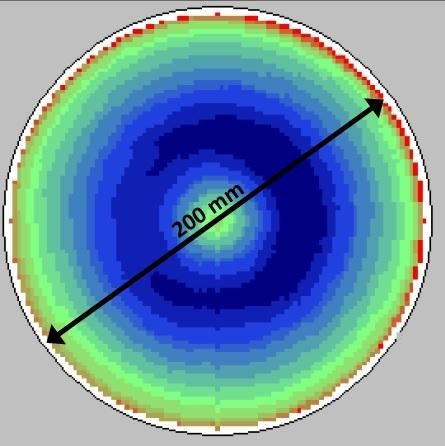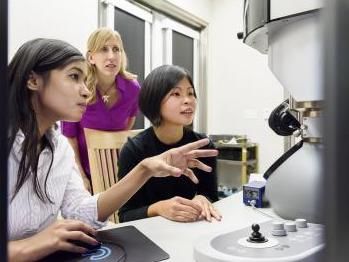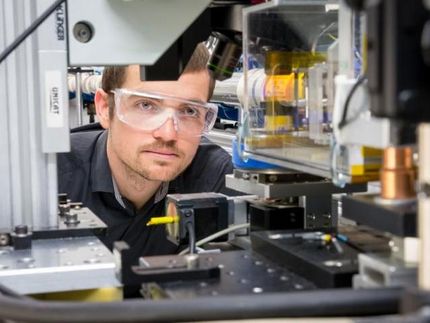Single nanoparticle mapping paves the way for better nanotechnology
Researchers at Chalmers University of Technology and the Technical University of Denmark have developed a method that makes it possible to map the individual responses of nanoparticles in different situations and contexts. The results pave the way for better nanomaterials and safer nanotechnology.

Svetlana Alekseeva and co-workers have produced maps of individual nanoparticles. The eight images show eight different nanoparticles of the same substance, palladium. Each nanoparticle consists of a number of grains, which are displayed as different coloured fields on the images. The properties and response patterns of the various grains differ, and these in turn determine the properties and responses of the nanoparticles when they come into contact with other substances.
Svetlana Alekseeva
In the future almost all new technology will be based on nanotechnology in some form. But nanoparticles are temperamental personalities. Even when they look the same from a distance, they are obstinately individual when you zoom in to each individual one.
Svetlana Alekseeva and Christoph Langhammer at Chalmers University of Technology in Sweden, together with researchers at the Technical University of Denmark, have discovered why different polycrystalline nanoparticles behave so distinctly when they come into contact with hydrogen. This knowledge is essential in order to develop better hydrogen detectors, which are expected to play an important role in the safety of hydrogen cars.
"Our experiments clearly showed how the reaction with hydrogen depends on the specifics of the way in which the nanoparticles are constructed. It was surprising to see how strong the correlation was between properties and response - and how well it could be predicted theoretically," says Svetlana Alekseeva, a Postdoc at the Department of Physics at Chalmers University of Technology.
A nanoparticle of a certain material is comprised of a number of smaller grains or crystals. The number of grains and how they are arranged is therefore crucial in determining how the particle reacts in a certain situation or with a certain substance.
Alekseeva and her collaborators have produced maps - effectively virtual portraits - of individual palladium nanoparticles. The images show the grains as a number of fields which are combined into a map. Some particles consist of a large number of grains, others have fewer grains, and the fields border on one another in different ways.
This new method of characterising nanoparticles is based on a combination of electron microscopy and optical microscopy. The same individuals are examined using both methods and it is possible to monitor their response when they encounter other substances. This therefore makes it possible to map the basic material properties of nanoparticles at an individual level, and see how these correlate with the response of the particles when they interact with their environment.
As a result an almost infinite range of possibilities are opened up for further research and for the development of products and nanomaterials which are both technically optimised and safer from an environmental and health perspective.
The nanoparticles that have been investigated also operate as sensors in themselves. When they are illuminated, they reveal how they react with other substances, such as various gases or fluids. Langhammer's research team is currently working on several projects in this area, including some relating to hydrogen detection.
But knowledge about nanoparticles is needed in a range of different fields in society. These include, for example, in new electronic devices, batteries, fuel cells, catalytic converters, textiles and in chemical engineering and biotechnology. There is still a lot we do not know about how these small particles operate or will come to affect us and the environment in the long term.
"Nanotechnology is developing fast in the world, but so far the research into nanosafety is not happening at the same pace. We therefore need to get a much better grasp of the risks and what distinguishes a hazardous nanoparticle from a non-hazardous one," says Christoph Langhammer, Associate Professor at the Department of Physics, at Chalmers.
"Our work indicates that not everything is what it seems - it's the details that are crucial. To understand if and why nanoparticles are hazardous to humans, animals or nature, we also need to look at them individually. Our new method now allows us to do this."
Original publication
Svetlana Alekseeva, Alice Bastos da Silva Fanta, Beniamino Iandolo, Tomasz J. Antosiewicz, Ferry Anggoro Ardy Nugroho, Jakob B. Wagner, Andrew Burrows, Vladimir P. Zhdanov & Christoph Langhammer; "Grain boundary mediated hydriding phase transformations in individual polycrystalline metal nanoparticles"; Nature Comm.; 2017
Original publication
Svetlana Alekseeva, Alice Bastos da Silva Fanta, Beniamino Iandolo, Tomasz J. Antosiewicz, Ferry Anggoro Ardy Nugroho, Jakob B. Wagner, Andrew Burrows, Vladimir P. Zhdanov & Christoph Langhammer; "Grain boundary mediated hydriding phase transformations in individual polycrystalline metal nanoparticles"; Nature Comm.; 2017
Topics
Organizations
Other news from the department science
These products might interest you

NANOPHOX CS by Sympatec
Particle size analysis in the nano range: Analyzing high concentrations with ease
Reliable results without time-consuming sample preparation

Eclipse by Wyatt Technology
FFF-MALS system for separation and characterization of macromolecules and nanoparticles
The latest and most innovative FFF system designed for highest usability, robustness and data quality

DynaPro Plate Reader III by Wyatt Technology
Screening of biopharmaceuticals and proteins with high-throughput dynamic light scattering (DLS)
Efficiently characterize your sample quality and stability from lead discovery to quality control

Get the chemical industry in your inbox
By submitting this form you agree that LUMITOS AG will send you the newsletter(s) selected above by email. Your data will not be passed on to third parties. Your data will be stored and processed in accordance with our data protection regulations. LUMITOS may contact you by email for the purpose of advertising or market and opinion surveys. You can revoke your consent at any time without giving reasons to LUMITOS AG, Ernst-Augustin-Str. 2, 12489 Berlin, Germany or by e-mail at revoke@lumitos.com with effect for the future. In addition, each email contains a link to unsubscribe from the corresponding newsletter.
Most read news
More news from our other portals
Last viewed contents

Electrons use the zebra crossing - Exotic Patterns of interacting electrons at the metal-insulator transition

GaN-on-Silicon for scalable high electron mobility transistors
Open_hearth_furnace

Maize and milk proteins can replace fossil fuels and metals in the production of nanostructured surfaces - Sustainably produced nanotechnology
Activin
TGF_beta
Basell launches new Metocene metallocene-based polypropylene grade targeted to customer TWIM
Eindhoven researchers observe shell growth thanks to 'ion sponge' - Revolutionary microscope technology confirms 30-year-old theory
Pfizer Acted Responsibly In Sharing Celebrex Alzheimer's Study Data With FDA - Public Citizen Charge is Misleading and Unfair to Patients
R&D for Next-Generation Solid State Batteries - Partnership between Fraunhofer and Hydro-Québec





























































